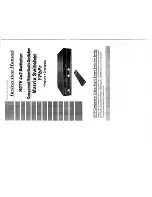
KRAMER ELECTRONICS LTD.
4
1.
INTRODUCTION
Congratulations on your purchase of this Kramer Electronics switcher.
Since 1981 Kramer has been dedicated to the development and manufacture of high quality video/audio
equipment.
The Kramer industrial line has become an integral part of many of the best video/audio production and
presentation facilities around the world. In recent years, Kramer has redesigned and upgraded most of the
industrial line, making the best even better. Kramer’s line of professional video electronics is one of the most
versatile and complete available, and is a true leader in terms of quality, workmanship, price/performance ratio
and innovation. In addition to the Kramer line of high quality video switchers, such as the one you have just
purchased, Kramer also offers a full line of high quality industrial and broadcast distribution amplifiers,
processors, interfaces, controllers and computer-related products. Kramer welcomes your inquiries for Kramer
equipment or custom-manufactured products, engineering, private labeling and OEM manufacturing per your
specifications.
This manual includes configuration, operation and option information for the following products from the
Kramer VS line of video switchers. These VS switchers are similar in operation and features and differ in their
audio input and output type.
Balanced Audio Family:
VS-1211
- 12x1 composite/single component video & balanced audio switcher.
VS-1011
- 10x1 composite/single component video & balanced audio switcher.
VS-811
- 8x1 composite/single component video & balanced audio switcher.
VS-611
- 6x1 composite/single component video & balanced audio switcher.
VS-411
- 4x1 composite/single component video & balanced audio switcher.
Unbalanced Audio Family:
VS-1201xl
- 12x1 composite/single component video & unbalanced audio switcher.
VS-1001xlm
- 10x1 composite/single component video +DA & unbalanced audio switcher.
VS-801xlm
- 8x1 composite/single component video +DA & unbalanced audio switcher.
VS-601xlm
- 6x1 composite/single component video +DA & unbalanced audio switcher.
VS-401xlm-
4x1 composite/single component video +DA & unbalanced audio switcher.
1.1 A Word on Video/Audio Switchers
A video/audio switcher usually switches between several sources (inputs) and one or more acceptors (outputs).
A switcher that allows several inputs to be connected to several outputs simultaneously is called a Matrix
Switcher. Switchers may be of the electronic or mechanical type. Most matrices are of the active electronic type,
with many crosspoints. Vertical Interval Switching, frequently used in video, ensures that the transition from
one video source to another (such as switching between two genlocked cameras) is smooth and without
interference. The switching and changeover is done during the blanked vertical interval period, when the
transition is hidden.
Genlocked means synchronized so that the color and phase information from each source is identical. Thus
switching is done with no interference, no rolling, no color loss and no jumping on the screen. Since the
Syncs come with the same timing, all the information is identical and the transition between one source and
the other is smooth.
Vertical Interval Switching is needed when recording or transmitting a video program involving several video
sources, as in live broadcast, to ensure clean, undisturbed picture transitions.
Matrices and switchers may sometimes be RS-232 or RS-485/422 controlled. Each of these options is a way of
remotely controlling a video/audio device (switcher, SEG, etc.) using a PC with a serial port, or another device
that uses a similar communication protocol.
The range consists of a number of models, having between twelve and four inputs, as indicated by the model
name. The audio output is either balanced or unbalanced. Switching is effortless and is performed during the
vertical interval of source #1, or of the video available at the external Sync socket. The switchers can be
controlled by touch buttons on the front panel, by a PC, via the switcher's built-in RS-232 and/or RS-485/422
communication ports, or by contact closure via a remote socket on the back panel.





































